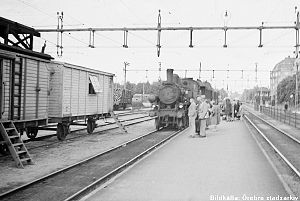Svartåbanan
| Örebro C – Svartå | |||||||||||||||||||||||||||||||||||||||||||||||||||||||||||||||||||||||||||||||||||||||||||||||||||||||||||||||||||||||||||||||||||||||||||||||||||||||||||||||||||||||||||||
|---|---|---|---|---|---|---|---|---|---|---|---|---|---|---|---|---|---|---|---|---|---|---|---|---|---|---|---|---|---|---|---|---|---|---|---|---|---|---|---|---|---|---|---|---|---|---|---|---|---|---|---|---|---|---|---|---|---|---|---|---|---|---|---|---|---|---|---|---|---|---|---|---|---|---|---|---|---|---|---|---|---|---|---|---|---|---|---|---|---|---|---|---|---|---|---|---|---|---|---|---|---|---|---|---|---|---|---|---|---|---|---|---|---|---|---|---|---|---|---|---|---|---|---|---|---|---|---|---|---|---|---|---|---|---|---|---|---|---|---|---|---|---|---|---|---|---|---|---|---|---|---|---|---|---|---|---|---|---|---|---|---|---|---|---|---|---|---|---|---|---|---|---|---|
|
Last steam train on September 6, 1937
| |||||||||||||||||||||||||||||||||||||||||||||||||||||||||||||||||||||||||||||||||||||||||||||||||||||||||||||||||||||||||||||||||||||||||||||||||||||||||||||||||||||||||||||
| Route length: | 50 km | ||||||||||||||||||||||||||||||||||||||||||||||||||||||||||||||||||||||||||||||||||||||||||||||||||||||||||||||||||||||||||||||||||||||||||||||||||||||||||||||||||||||||||||
| Gauge : | 1435 mm ( standard gauge ) | ||||||||||||||||||||||||||||||||||||||||||||||||||||||||||||||||||||||||||||||||||||||||||||||||||||||||||||||||||||||||||||||||||||||||||||||||||||||||||||||||||||||||||||
| Power system : | 15 kV 16 Hz ~ | ||||||||||||||||||||||||||||||||||||||||||||||||||||||||||||||||||||||||||||||||||||||||||||||||||||||||||||||||||||||||||||||||||||||||||||||||||||||||||||||||||||||||||||
| Dual track : | since 1914: Örebro C – Örebro Södra | ||||||||||||||||||||||||||||||||||||||||||||||||||||||||||||||||||||||||||||||||||||||||||||||||||||||||||||||||||||||||||||||||||||||||||||||||||||||||||||||||||||||||||||
|
|||||||||||||||||||||||||||||||||||||||||||||||||||||||||||||||||||||||||||||||||||||||||||||||||||||||||||||||||||||||||||||||||||||||||||||||||||||||||||||||||||||||||||||
The Svartåbahn ( Swedish Svartåbanan ) was a railway line in Sweden . It ran over a length of 50 km from Örebro to Svartå ( Degerfors municipality ) through the western part of Närke . In Örebro there was a connection to Ervalla and Hallsberg; in Svartå, the line connected to the Värmlandsbahn , which runs from Oslo to Laxå / Hallsberg with a connection to Stockholm .
history
In 1894, the private company Örebro-Svartå järnväg AB (ÖrSJ) received the concession to build the line, which was put into operation on October 1, 1897 after two years of construction. The traffic was carried out by the also private Köping-Hults järnväg (KHJ), which was bought by Statens Järnvägar (SJ) as early as 1900 . On January 1, 1907, the ÖrSJ was nationalized.
The increase in competing bus traffic prompted the state railway to set up more stops on the railway in the 1920s. Along with the electrification of the Värmlandsbahn , the Svartåbahn was electrified in 1937.
Traffic and decommissioning
The route was primarily used for local traffic. Until the construction of the triangle track in Laxå, part of the long-distance traffic Oslo – Värmland – Stockholm was routed over the Svartå Railway to avoid a change of direction in Laxå. Since the 1960s, the timetable has been reduced on the line piece by piece; first decommissioning intentions by SJ dating from 1967. Through the different services on the route, many built as railway stations were departments over the years partially reclassified several times, also sidings transferred to the company and these decommissioned.
On December 13, 1971, the route was relocated due to road construction in the Bista area. From 1973 the trains on the Karstad – Stockholm route no longer stopped in Svartå. As of June 18, 1973, the remaining charging stations Åbyverket, Ekströms and Bista were connected to the central signal box in Örebro and given up as a local independent operating point.
The weekend traffic was switched to buses in 1975. In 1978, railcars replaced the locomotive-hauled trains. In the course of the transfer of responsibility for regional local transport to the Swedish provinces ( län ), the future of the Svartå Railway was discussed from 1982 onwards. Since the local transport company Länstrafik i Örebro (LTÖ) refused to take over responsibility for the Örebro – Svartå rail transport from the summer of 1985, the Swedish Parliament decided on May 29, 1985 to shut it down from July 1, 1985. The last scheduled passenger train was running as early as June 29, 1985.
The line was largely dismantled in the years 1990–1991, only the Örebro Södra – Bista section is still (no longer electrified), as is the entrance to Svartå station.
Industrial railways
In the catchment area of Svartåbanan, numerous industrial railways of different gauges have been built, all of which have now been dismantled:
| route | Track width in mm |
|---|---|
| Karlslund station - Karlslunds kvarn | 1435 |
| Latorpsbruk station - Garphytte bruk | 600 |
| Latorpsbruk station - Alunbrottet | ? |
| Holmstorp lastplats - Klara gruvor | 600 and 750 |
| Lannabruk lastplats - Lanna kalkbruk | 500 |
| Fjugesta station - Fjugesta tegelbruk - Lertaget | 500 |
| Fjugesta grusgrop lastplats - Fjugesta grusgrop | 1435 |
| Gropen station - Gropens såg | 1435 |
| Slästorps torvströfabrik - Övratorpsmossen | 600 |
| Ingvaldstorp lastplats - Hultamossen | 500 |
| Mullhyttemo station - Stockås torvströfabrik | 891 (electrical operation) |
| Stockås torvströmfabrik | 500 and 600 |
| Västanås torvströfabrik | 600 |
| Svartå station - Svartå bruk | 1435 |
Future prospects
At the beginning of 2010, a feasibility study regarding the construction of a new railway line Kristinehamn - Karlskoga - Örebro was discussed in order to better connect Värmland to the rail network. This railway should not have the same route as the Svartå Railway, but rather open up Karlskoga. The aim should be to shorten the travel time between Örebro and Karlstad and beyond that between Örebro and Kristinehamn and between Karlstad and Oslo significantly. Financial resources could be included in the infrastructure plan until 2021, so that construction can be expected in the next 20 years at the earliest.
Web links
Individual evidence
- ↑ see description by Stig Lundin
- ↑ a b c page of the museum association
- ↑ karlskoga.se: 12th tobacco shop. (PDF) Retrieved January 19, 2016 .
- ↑ Fredrik Persson: Nobelbanan måste börja byggas nu! In: Gröna Bloggar. March 21, 2014, accessed January 19, 2016 (Swedish).
- ↑ Upprättad av Kjell Säfvestad, ÅF Infrastructure AB PM Angående förstudie av Nobelbanan - ny järnvägsförbindelse Kristinehamn-Örebro February 16, 2010

